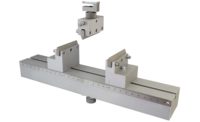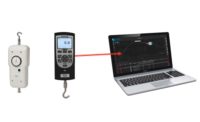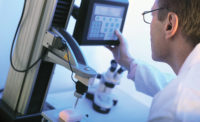Force Testing
Single-column force testers offer practical and affordable force testing solutions.

This is a universal force tester with an integrated electronic load cell. Source: AMETEK

Here is a motorized test stand with a digital force gage. Source: AMETEK

A manually adjustable test stand with a force gage is shown here. Source: AMETEK



Single-column testers today represent the largest single market segment of the force testing marketplace for a number of reasons. Among them is their utility across a broad range of applications. Capacities for single-column testers now typically range from a couple of ounces up to 500Lbf, with a few models offering capacities up to 1,000Lbf.
Another reason is their affordability. Single-column testers are among the least expensive force testing devices available, with models starting at several thousand dollars, allowing users to purchase them without having to justify a major capital appropriation.
Compact design is another reason. Single-column testers with their reduced footprint require far less space than their dual-column counterparts and often are set up on a workbench or tabletop.
There also is the practicality of single-column testers in force measurement applications, especially with the rise in miniaturization of higher performance products and materials and their integration into a broader range of complex, compact devices.
Manufacturers and end users need to reliably determine the ability of materials, products and devices to withstand a greater array of forces and conditions. Single-column force testers offer an ideal and cost-effective solution for lower force testing of wearable technology, medical implants, electronic components, thin films, and micro mechanical assemblies.
In addition, single-column force testers are widely used across industries in testing packaging, paper, plastics, textiles, medical devices, pharmaceutical products, foods and beverages. They also are relied upon by industries ranging from aerospace to semiconductors to assure continuing compliance with performance and reliability standards.
Contributing to the broad application of single-column force testers is the range of testing machines available from manual and electromechanical stands to fully automated force testing systems.
Different Types of Single-Column Force Testers
Single-column force testers can be split into three basic categories:
Manual Test Stands with Force Gage: This tester combination is the most economical solution for tests that don’t require a constant speed. The force gage may be mounted either to an adjustable or fixed arm of the tester. The movement of the arm is either driven with a lever or hand wheel actuator. Most manufacturers will offer displacement or position measurement options mounted to the frame.
Motorized Stand with Force Gage: The motorized solution integrates a motor drive with an adjustable speed. The force gage is typically mounted to the motor-driven arm. Adjustable mechanical limit switches allow the user to set the upper and lower travel areas. That also prevents accidental collision into grips and fixtures mounted to the tester. A digital force gage can be connected to the tester to stop the tester when it reaches a pre-selected force.
Universal Force Testers: Universal force testers use a load cell with integrated electronics instead of a force gage. The electronics can be mounted to the frame in the form of a tablet or console or built into the frame enclosure. The test programs are stored in the electronics and can be password protected. These devices feature USB and serial data outputs and can use dedicated or non-dedicated load cells. The PC also stores test results and plot the graphs from data points that also can be exported to a data acquisition system.
Force Gages
Two types of force gages are commonly available: digital and mechanical. Mechanical gages have a dial indicator with a second needle or a mechanism to capture peak loads. Basic digital gages have peak force detection, analog and digital outputs, and unit of measurement selection. Higher end digital force gages include all of the basic features and, in addition, may have a color display, include data storage, statistical calculations, interface to PC with software, Bluetooth technology, selectable sampling rates and allow user password protection. Small adaptors, such as the chisel, flat notch and hook point, are typical accessories that come with force gages.
Grips and Fixture Guidelines
Tension and compression fixtures and grips make up the majority of adaptors used in force testing. Users also have the choice of building custom fixtures that mount easily to the “T” Slot worktables that are available on most force testers. Below are examples of the most common grips and fixtures with guidelines to help users in the decision-making process.
Wedge Action Grips – Wedge action grips are spring loaded, self aligning, auto tightening grips. The clamping force increases as the load increases. These grips can be used with plastic, metals and rubber as long as the grip faces don’t create a break point in the sample.
Vise Action Grips – Vise action grips provide a flexible solution and make it easy to grip test specimens at an affordable price compared to wedge action grips. Vise action grips have a diverse jaw faces and sizes to choose from, allowing the testing of different sample widths. These grips could be considered the universal grip.
Grip Face Selection – The key in choosing the proper grip face is to consider the surface area, hardness and shape of the sample to be tested. Then determine what type of grip face is needed to assure the best combination between the sample and the jaws, while minimizing slippage and rupture in the grip faces. Grip faces come in many shapes and forms such as plain faces, diamond pattern, wave faces, rubber faces, cross-cut faces, carrier faces and V-notched faces. These different face patterns are available in different sizes and depths. As an example, performing a tension test on thin film using grip faces with deep serrated pattern will most likely rupture in the jaw and fail the test.
Compression Plates and Adaptors – Compression plates and adaptors come in many shapes and forms and are used in many applications. They are available in different diameters, thicknesses and lengths for use in puncture testing.
When deciding on a single-column tester, several key questions need to be answered.
- What is the maximum force applied during the test and what consideration does that have on possible future testing? Will a single-column tester have the force capacity for future testing needs?
- What accuracy is required from both the force and displacement measurements?
- Is speed an important parameter, and if so, what speed? If speed is not important a manual tester with a gage may suffice.
- Is the goal to have a long-term relationship with the supplier/distributor and is a different model tester from the same manufacturer a consideration?
- How many years has the supplier been in business and can the supplier provide solutions for future applications?
- What types of grips are needed?
- Can the supplier perform repair and calibration services?
Conclusion
Single-column force testers are a cost-effective solution for the testing of low-force force products with force ranges up to 500 / 1,000Lbf. With the many different models and types of single-column testers available, there is likely a version to fit practically every budget. Their compact footprint allows single-column tester to be placed on a bench or tabletop in a lab with minimum encumbrance. The nearly unlimited choice of test fixtures and grips makes the single-column tester an ideal choice for a wide range of low-force tests requirements. And, with the diversity and versatility of today’s single- column force testers, the choice of manufacturer and supplier is a key consideration, especially in terms of sales, service and support as well as future testing requirements.
Looking for a reprint of this article?
From high-res PDFs to custom plaques, order your copy today!










